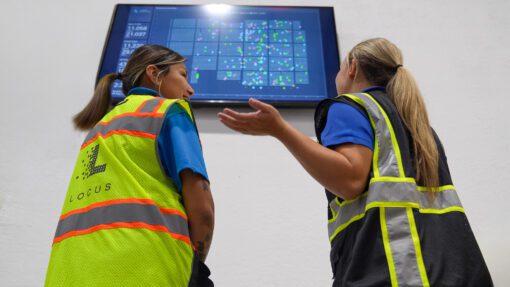WP: How to achieve 400 UPH with Locus Fast Pick
WP: How to achieve 400 UPH with Locus Fast Pick Download Now!
Cybersecurity Predictions for 2024
Fouad Khalil, Sr. Dir., Ent. Security, Risk & Compliance

As we enter this new year, the digital horizon and security can be both exhilarating and daunting. The integration of Generative AI (GenAI) into enterprise infrastructure heralds a new era of innovation but also introduces unprecedented security vulnerabilities. From AI-powered cyber-attacks reminiscent of the Morris worm to sophisticated disinformation campaigns amid global events, the cybersecurity landscape is poised for tumultuous changes.
With the digital realm becoming an ever more integral part of our lives, understanding and preparing for these emerging threats is not just prudent; it’s imperative. This blog post delves into the critical cybersecurity predictions for 2024, underscoring the challenges and opportunities that lie ahead for enterprises navigating this complex terrain.
GenAI / Machine Language
With enterprises beginning to embed GenAI into their infrastructure and leveraging machine language, they’re bringing new risks into their organizations. These risks are introduced by centralizing various types of data into AI models, various stakeholders accessing those models and ingesting data, as well as the actual inference and live use of the model.
AI Used for Cyber-attacks
The Morris worm is widely believed to be the first cyberattack ever reported back in 1988. I think in the relatively near term we’ll see a “Morris Worm-like” event where AI is confirmed being used to scale a malicious campaign.
Year of Unexpected Events
2024 is going to be a busy year for cyber criminals amid ongoing geopolitical tensions with major elections in the U.S. and European Union and the biggest sporting event in the world (Paris Olympics) all taking place within a few months of each other. It’s a perfect storm of events that’s going to see disinformation campaigns on a whole new level.
Government Security Support
Along with the major elections, keep in mind that many security programs are reliant on the federal government, as the current administration needs to support your cause. Consider what you would do if you had to wait four years or more to handle a security threat because you didn’t have that support or the ability to, for example, call government bodies for their involvement if needed.
Doppelgänger Threat
With millions of valid enterprise credentials on the Dark Web right now and the number continuing to rise, attackers are weaponizing identity, viewing it as a stealthy means of gaining access to over privileged accounts. In the next year, I expect we’ll see more “doppelgänger” users popping up in enterprise environments, with users behaving a certain way one day and another way the next — this abnormal behavior should be an enterprise’s sign that their systems are being compromised. Attackers are assuming legitimate users’ digital identities unbeknownst to them, such as the help desk call to MGM, with this trend only exacerbating in 2024. Security and password hygiene have never been more important.
Ransomware on the Decline
Ransomware attacks are on the decline as more countries pledge not to pay the ransom and increasingly fewer enterprises succumb to the pressure of encrypted systems — choosing to divert funds to rebuilding systems versus decrypting systems.
Cyber Resilience and Recovery
These programs enable organizations to withstand, adapt to, and recover from cyberattacks. Cyber resilience and recovery require a holistic and proactive approach that accounts for people, processes, and technology. You can’t plan cyber resilience strategies in a silo. Instead, they have to be a top-down approach.
Enterprise Identity Crisis
As organizations continue expanding their cloud services and applications, each one brings its own disparate identity capabilities — creating a web of disconnected identity profiles and capabilities across cloud, on-premise systems and applications. In the past, organizations hoped to consolidate these identities via a single identity solution or platform, but in today’s reality, organizations are coming to terms with the fact that this approach is neither practical nor feasible.
Supply Chain Attacks
These attacks target the vendors, partners, or service providers of an organization, rather than the organization itself. By compromising the trusted third parties, attackers can gain access to the organization’s network, data, or systems. To combat this, C-suite executives should conduct regular cybersecurity audits and third party risk assessments of their supply chain partners and enforce strict contractual obligations and standards. They should also monitor and limit the access and privileges of third parties and implement multi-factor authentication (MFA) and encryption.
Cloud Security Breaches
These attacks exploit the vulnerabilities or misconfigurations of cloud services or platforms. This attack vector can expose sensitive data, compromise applications, or disrupt operations. C-level executives can prevent cloud breaches by adopting a shared responsibility model wherein they ensure that their cloud providers meet the required security and compliance standards and that they implement their own security controls and policies. They should also use tools and services that can monitor and detect cloud security issues and remediate them quickly.
Regulatory and Compliance Challenges
These are the legal and ethical issues that arise from the use or misuse of data, technology, or cybersecurity measures. Organizations must comply with various regulations and standards, such as the EU General Data Protection Regulation (GDPR), the US State of California Consumer Privacy Act (CCPA), the Payment Card Industry Data Security Standard (PCI DSS), and the US Health Insurance Portability and Accountability Act (HIPAA). Non-compliance can result in fines, legal action, or reputational damage. Compliance can be achieved if C-suite executives establish a compliance framework that requires them to assess and monitor their compliance status and implement necessary policies and procedures. They should also stay up to date on the changing regulatory and compliance landscape and engage with regulators and policymakers.
As we venture further into 2024, the cybersecurity predictions outlined paint a picture of a digital battleground, shaped by the forces of innovation and malice in equal measure. The rise of GenAI, the specter of AI-driven cyber-attacks, the proliferation of disinformation, and the stealthy menace of “doppelgänger users” are but a few of the challenges that define this new era. Yet, amid these threats, there lies a path to resilience. Cyber resilience and recovery, stringent identity management, robust supply chain defenses, and cloud security strategies emerge as beacons of hope.
As enterprises grapple with these challenges, the essence of our digital future hinges on a proactive, holistic approach to cybersecurity. The journey ahead is fraught with peril, but with vigilance, innovation, and a steadfast commitment to security, we can navigate the stormy seas of 2024 and emerge stronger on the other side. Let’s embrace this challenge, armed with knowledge and the resolve to protect our digital world.
To find out more about our stance on security and compliance, please visit our Trust Center.
About the Author
As Senior Director, Compliance at Locus Robotics, Fouad is responsible for internal and external compliance programs, auditor education, alignment with industry best practices and cross-functional support. He brings extensive experience in the technology space with more than 25 years spanning disciplines in software development, IT support, program and project management and most recently IT Security and Compliance management. Khalil’s career path in technology has provided him with keen insights in the areas of network, system and database administration, software programming, system, software and GUI design, project and product development, solution implementation and much more. For nearly the past two decades, Khalil has focused on data security, security investigations, cybersecurity, security training and awareness, and security compliance– serving as an industry expert in key areas such as IT, NIST, Internal Controls over financial reporting, Sarbanes-Oxley, GDPR, CCPA, PCI DSS, HIPAA and HITECH. Khalil holds a Bachelor’s degree in Electrical and Computer Engineering from Marquette University and CISA, CDPSE and ITIL Foundations certifications. Additionally, he is an active member/contributor in ISACA, IIA and Infragard.




